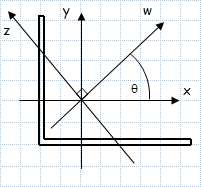Angle Properties.xls

Description
Angle properties used in design. For those non-standard sized angles not listed in the AISC tables. Checked with standard sized angles.
Calculation Reference
Construction Manual, 13th ed. P. 17-42
The AISC Steel Construction Manual, 13th Edition, is an important resource for structural steel design. Although the manual does not specifically focus on angle properties, it does contain relevant information on angles and their use in structural steel design. Here are some angle properties used in design, as covered in the manual:
-
Geometric properties: The manual provides geometric properties of angles, such as the area (A), depth (d), width (b), thickness (t), and the radius of the fillet (r). These properties are essential when calculating forces, moments, and stresses in angles.
-
Moment of Inertia: Moment of inertia (I) is a measure of an angle's resistance to bending. The manual provides formulas for calculating the moment of inertia about the x-axis (Ix) and the y-axis (Iy) for a given angle. This information is important for designing members subject to bending loads.
-
Section Modulus: Section modulus (S) is a measure of an angle's capacity to resist bending stresses. The manual provides formulas for calculating the section modulus about the x-axis (Sx) and the y-axis (Sy) for a given angle. Section modulus is used in the design of members subjected to bending loads to ensure they have adequate strength.
-
Plastic Section Modulus: Plastic section modulus (Z) is a measure of an angle's capacity to resist plastic deformation under bending loads. The manual provides formulas for calculating the plastic section modulus about the x-axis (Zx) and the y-axis (Zy) for a given angle. This property is important when designing members that experience plastic deformation before failure.
-
Shear lag factors: Shear lag factors are used to account for reduced shear capacity in members with non-uniform stress distribution. The manual provides guidance on calculating shear lag factors for angles connected by bolts or welds.
-
Connection design: Angles are often used for connections, such as gusset plates, braces, and framing connections. The manual provides guidance on the design of bolted and welded connections using angles, including the calculation of shear, tension, and bearing capacities.
The AISC Steel Construction Manual, 13th Edition, covers various aspects of angle design and properties. By understanding these properties and following the guidelines in the manual, engineers can design safe and efficient steel structures using angles.
Calculation Preview
Full download access to any calculation is available to users with a paid or awarded subscription (XLC Pro).
Subscriptions are free to contributors to the site, alternatively they can be purchased.
Click here for information on subscriptions.
